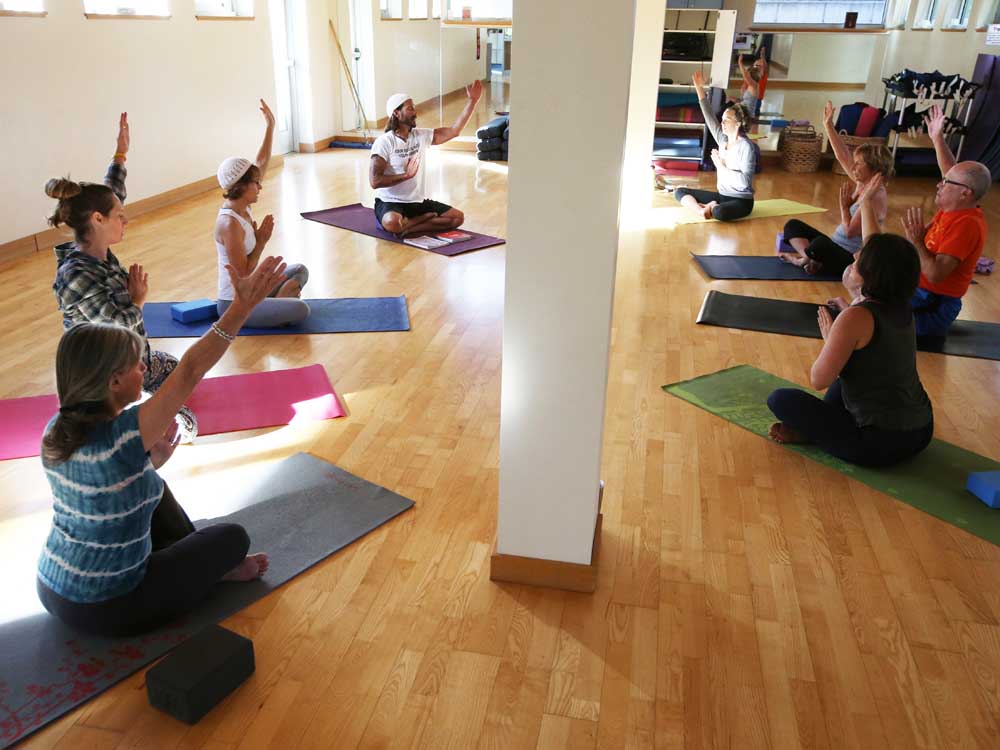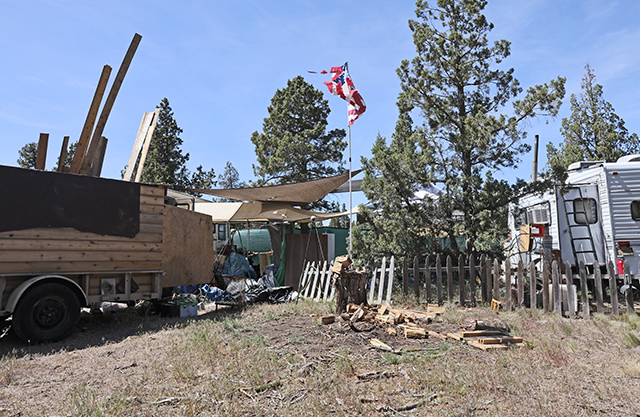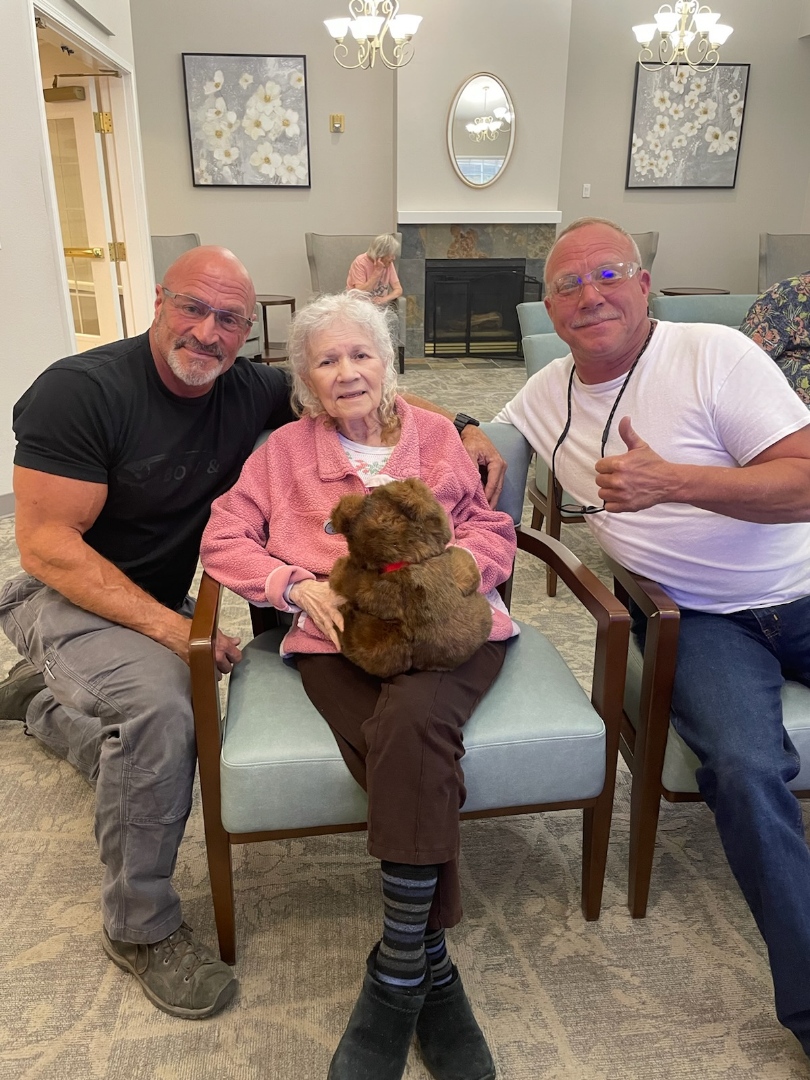Which yoga? A guide to styles in Central Oregon
Published 12:00 am Thursday, September 8, 2016

- Andy Tullis / The BulletinYoga instructor Santiago Casanueva, top left, leads a Kundalini yoga class at Juniper Swim & Fitness in Bend.
Over the years, Gina Chylak, of Bend, has taken several different kinds of yoga classes. But when her yoga instructor recently invited his class to stay for the following session, a class in Kundalini yoga, she was initially skeptical.
“I looked into it a little and said, ‘Eh, I don’t think that’s me,’” she recalled. “There was a lot of chanting, a lot of mantras and a lot of movement.”
Even after completing her first class, she wondered what she was doing there.
“I kept coming every week because I loved the teacher,” she said. “The more I learned about it and the more I opened up to it, the more I got out of it.”
There are at least seven different classical styles of yoga taught in Central Oregon, not including all the specialized classes targeting a specific demographic or the hybrid classes combining yoga with other forms of exercise. Juniper Swim & Fitness Center, run by the Bend Park & Recreation District, offers no fewer than 19 different types of yoga classes.
While many of them share the same poses and foundations, each offers at least a slightly different approach. Some may focus more on the fitness benefits of yoga, increasing the heart rate, building strength, balance and flexibility while others stress more of the mind-body connection underlying their traditions.
The following is a rundown of some of the yoga styles offered in Central Oregon and how they differ from one another.
Kundalini
“Kundalini is the yoga of awareness,” said Santiago Casanueva, who teaches the class at Juniper. “It is aligning breath and thought, creating a shift in consciousness.”
His 60-minute session is unlike most other yoga classes in town.
“Other yogas will focus primarily on the physical aspects, postures to be attained,” Casanueva said. “Kundalini yoga requires no physical attainment. You get there through breathing.”
There are no postures or poses; little balance or coordination is required. Participants sit on a yoga mat or block through most of the class, breathing in a rhythmic fashion synchronized with various movements. The class ends with participants dancing around the studio, chanting to music.
“It’s certainly at times a very physical practice, but it’s not what you would think of as yoga,” Chylak said. “I think of it kind of as restorative yoga for the mind and the soul.”
Ashtanga
This challenging, older form of yoga has inspired many of the vinyasa-type classes that dominate yoga in the West. Most often Ashtanga classes are taught “Mysore style” in which students learn six series of sequenced poses, and then practice on their own as the instructor provides one-on-one attention. The nonstop series poses are performed in the same order in each class. Ashtanga relies on a special breathing technique to focus the mind and control the flow of breathe through the body. Particular attention is placed on doing each posture correctly before moving on to more difficult sequences.
Baptiste Power Vinyasa
Sometimes described as a blend of Bikram, Iyengar and Ashtanga, Baptiste Power Vinyasa is a physically challenging tradition that provides a vigorous workout. Classes are held in heated rooms, usually around 90 degrees, not quite to the temperatures in Bikram Yoga studios. The poses will be familiar to most yoga enthusiasts, although classes do not follow a predetermined sequence. Baptiste encourages participants to follow their own intuition, rather than adhere strictly to the instructor’s direction.
Bikram
The original “hot yoga,” Bikram studios heat their classrooms to over 100 degrees, prompting many attendees to check the thermostat as soon as they enter.
“The people come in and look at my thermometer and say it’s 118,” said Suzy McLagan, owner of Bikram Yoga Bend. “It’s not. The temp is around 104.”
McLagan said the heat is intended to open up circulation, to get the blood flowing a little quicker. Classes consist of 26 postures and two breathing exercises conducted in the same sequence each time, with one posture flowing into the next in a way designed to work the entire body. Still, McLagan says each class feels a little bit different.
“What you’re not able to do today, you may be able to do tomorrow,” she said. “And what you might be able to today, you might not be able to do tomorrow. That’s kind of the fun of it.”
Iyengar
Perhaps more than any other form of yoga, Iyengar is a stickler about precision and attention to detail. Classes tends to include fewer poses, focusing more on getting them right.
“It’s the articulation and refinement of the poses where Iyengar is noticeably different,” said Nadine Sims, owner of Iyengar Yoga of Bend. “We really work to have the leg straight and to bend to a specific degree when it’s supposed to be bent, instead of just letting it slide.”
Iyengar instructors go through a rigorous training and accreditation, more so than is required for many other forms of yoga, and freely share their knowledge of anatomy and form during classes. They’re trained to evaluate students during class to determine what they need to do to bring themselves into balance. Iyengar make use of props to help beginners attain proper alignment and to help attendees hold the pose longer. This is not the yoga for folks who don’t like to be corrected.
Sivananda
This form of yoga typically focuses on the same 13 basic postures, starting with an active sun salutation and ending with a relaxing corpse pose.
“One of the major differences is that you’re going into deep relaxation between poses,” said Kelly Giebelhaus, a Sivananda instructor at the Juniper Swim & Fitness Center.
In contrast to some of the more vigorous yoga classes that keep your heart rate up the entire, Sivananda starts out active, but then shifts to the less intense.
“Toward the end of the class, there’s more restorative types of poses and you’re holding these poses a little bit longer,” she said.
Yin
At the opposite end of the spectrum from some of the power yogas, Yin is a more calm, meditative form of yoga where poses are held for much longer, often up to two to five minutes.
“It’s mostly seated postures that are designed to open up hips, hamstrings, lower back and toes,” said Nicole Rainey, owner of Juniper Yoga in Bend. “Pretty much from your pelvis on down is what we focus on in Yin Yoga.”
Yin comes from China and has strong associations with the practices of Chinese medicines. It’s particularly popular among runners and a great complement to rigors of competitive athletics.
“It’s a meditative practice,” Rainey said. “It’s great for beginners because they get to know the foundational postures with no pressure to move quickly or perform them with perfect alignment.”
— Reporter: 541-633-2162, mhawryluk@bendbulletin.com






